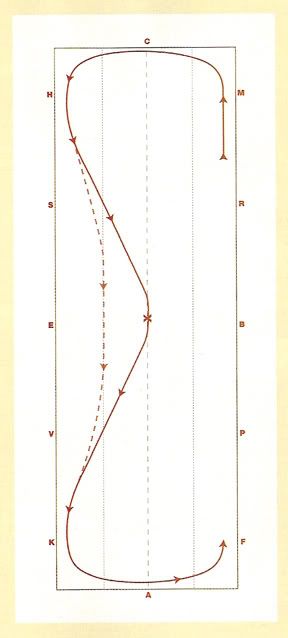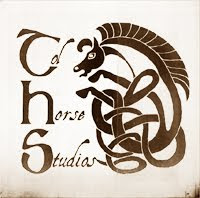Come along
I guess it's been a while since I posted about the moose. Things have been going quite well, actually. I've been working on the counter-canter exercises from the previous posts, as well as the third exercise of that series (which I'll get into in a minute). We've been running through Training Level Test Three rather consistently. I only haven't moved on because I kept forgetting to memorize the T4 test, haha.
The other day I did That Awful Thing to him before we rode. (Pulled some of his mane.) Really, that horse. He flings his head up and braces his neck even before I pick up his mane. And I do it so carefully (and correctly, I might add--choosing tiny sections and pulling it closely from the root). There's really no reason for his melodramatic response. Sometimes he even tries to knock me off the stool I stand on. Of course, once I did get on to ride, he was perfect. Even a tad on the sensitive side, actually.
The third exercise in Leslie Webb's counter-canter work is a bit like the trot movement in T4, only (obviously) at the canter.
It's actually easiest to start this one at the trot, just to make sure there are no "You want me to do WHAT?" moments. But, actually, if you've been doing those counter-bent serpentine at all, you should be good to go. A few things to notice first: The dashed line is easiest to work on before gradually increasing the length of the diagonal (and thus the difficulty of the counter-canter work). Second, this figure isn't exactly like the MXF / MXK bend movements, as there is a stride or two of straightness around X.
I was really worried initially that Toler would get overexcited about this and try to do flying lead-changes at every possible opportunity. Luckily, that has yet to be the case. He's been doing fairly well with it, too, although I have yet to get a nice stride or two of straightness around X, mostly because he anticipates and then I just have to go with him so he doesn't drop his shoulder or do the "counter-bend collapse," as I've begun to call it. Going clockwise, Toler can get the straightness if we follow the shallower path, but once we get to the centerline, there's simply not enough room. Partially because, like I said, Toler gets excited, and partially because the indoor arena (the only place I can do these sorts of exercises) is only 20 x 40 meters, which does cause quite a bit of trouble when I start to school the higher tests. Movements are just shorter, and the test is always "rushed" in feeling. Granted, this makes for a wonderful ease and feeling when I'm actually riding in a standard dressage arena, but still. ;)
Going counter-clockwise, however, Toler has quite a bit of trouble. That is his harder way (his left stifle is the problem stifle, this that's his worse hip and canter direction). I generally start out on a path even shallower than the dashed line, and aim for a nice, balanced curve with no straight-aways. He has a harder time coming back for the counter-canter bend back onto the diagonal towards the rail, and an even harder time not collapsing into that section. But we're working on it. He's still getting better on the rail, in terms of that lead's straightness, but he still has a long way to go. We do a lot of medium-lengthening-medium canter transitions on the rail, which helps a lot, and I try to get him to do a stride of collected canter if that goes well in that direction.
I have noticed recently that I have started to lean when we go that direction. Thankfully, I catch myself. That would be an awful habit to get into--and one I never actually had, even as a younger rider. I was lucky enough to find a trainer who does not allow the excuse of "well, that's just what young/novice riders do." FYI, that's the STUPIDEST thing I have ever heard when it comes to learning equitation. In my opinion, young riders are even better at finding center balance than adult riders, so honestly, letting them lean is just a mark of laziness on the instructor's part. Mini-rant aside, I've got things to work on myself.
Ideally, we'll get Toler's stifle strengthened within the next month and a half, and I can start to push him more with cantering smaller circles, and canter-walk/halt transitions. That should really help with his quality of canter in general. I just don't want to do too much where his stifles are concerned.
Speaking of which, we had a very good day with that today. I let him have a day of lunge-work, and we started with walking poles, then I had him trot before and after the walking poles, which was a challenge he took seriously at first. But then it became a game for him to the point where he was leaping over three walking poles just to get to the trotting part again. He thought he was so clever he even had to buck and squeal about it. *Rolls eyes.*


Post a Comment